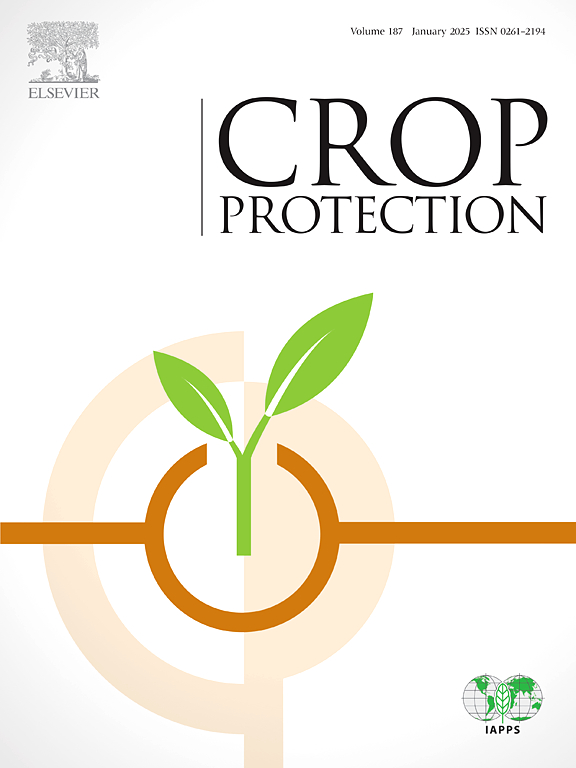IF 2.5
2区 农林科学
Q1 AGRONOMY
引用次数: 0
摘要
杂草对直播稻(DSR)构成了巨大挑战,因为它们阻碍了作物生长和产量。农民通常使用背负式喷雾器(BS)施用除草剂来管理杂草。然而,人工施药可能不连贯、劳动强度大,并对施药者的健康构成风险。本研究评估了无人驾驶飞行器(UAVs)施用除草剂管理杂草的效果,并评估了节省劳动力、成本和能源的情况。在印度哥印拜陀的泰米尔纳德邦农业大学进行了一项田间试验,试验时间为印度旱季(2022 年 8 月至 11 月)和蕾季(2022 年 12 月至 2023 年 3 月)。处理方法包括无人机和 BS 施用萌芽前(PRE)、萌芽后早期(EPOE)和萌芽后(POE)除草剂,以及无杂草和杂草检查地块。结果表明,与连续使用除草剂相比,单次施用 EPOE 能显著降低除草效率(WCE),并使产量减少 25-29%。在两种施药方法中,先用前除草剂 PRE 再用(fb)双草醚钠 POE 的组合产生的谷物产量最高。不过,与 BS 处理相比,无人机处理的净收益最高,可减少劳动力需求(50%)、施药成本(18%)和杂草管理总成本(13%)。此外,经济阈值分析证实,通过无人机连续施用除草剂可有效平衡成本和产量收益。此外,与 BS 方法相比,无人机施药大大减少了投入能源、施药时间以及生产 1 公斤稻米所需的能源。我们的研究结果表明,无人机施用除草剂,尤其是前草胺 PRE fb 双草醚钠 POE 组合,是一种有效的 DSR 除草措施,同时还能为农民带来有利的产量、收入和能源回报。为了节约资源和有效管理杂草,无人机可作为传统喷洒系统的可行替代品,用于在 DSR 中施用除草剂。本文章由计算机程序翻译,如有差异,请以英文原文为准。

UAV-based herbicide application for efficient weed control and resource savings in direct-seeded rice
Weeds pose a significant challenge to direct-seeded rice (DSR) as they hinder crop growth and yield. Farmers commonly use backpack sprayers (BS) for herbicide application to manage weeds. However, the manual application can be inconsistent, labor-intensive, and pose health risks to applicators. This research evaluates the effectiveness of unmanned aerial vehicles (UAVs) for herbicide application in management of weeds and assess labor, cost, and energy savings. A field trials were conducted at Tamil Nadu Agricultural University, Coimbatore, India during the kharif (August to November 2022) and rabi (December 2022 to March 2023) seasons. Treatments included UAV and BS application of pre-emergence (PRE), early post-emergence (EPOE), and post-emergence (POE) herbicides along with weed-free and weedy check plots. Results revealed that a single application of EPOE significantly reduced weed control efficiency (WCE) and recorded a yield reduction of 25–29% compared to sequential herbicide treatments. The combination of pretilachlor PRE followed by (fb) bispyribac sodium POE produced the highest grain yield in both application methods. Nevertheless, the UAV treatment yielded the highest net returns by reducing labor requirements (by 50%), application costs (by 18%), and total weed management costs (by 13%) compared to BS treatment. Furthermore, economic threshold analysis confirmed that the sequential application of herbicides through UAVs effectively balanced costs and yield gains. Additionally, UAV application significantly decreased the input energy, application time, and the energy required to produce 1 kg of rice compared to BS method. Our findings suggested that UAV application of herbicides, particularly the combination of pretilachlor PRE fb bispyribac sodium POE, is an effective weed control measure in DSR, while providing profitable yield, income, and energy returns for farmers. To conserve resources and effective weed management, UAVs can be serve as a viable alternative to conventional spraying systems for herbicide application in DSR.
求助全文
通过发布文献求助,成功后即可免费获取论文全文。
去求助
来源期刊

Crop Protection
农林科学-农艺学
CiteScore
6.10
自引率
3.60%
发文量
200
审稿时长
29 days
期刊介绍:
The Editors of Crop Protection especially welcome papers describing an interdisciplinary approach showing how different control strategies can be integrated into practical pest management programs, covering high and low input agricultural systems worldwide. Crop Protection particularly emphasizes the practical aspects of control in the field and for protected crops, and includes work which may lead in the near future to more effective control. The journal does not duplicate the many existing excellent biological science journals, which deal mainly with the more fundamental aspects of plant pathology, applied zoology and weed science. Crop Protection covers all practical aspects of pest, disease and weed control, including the following topics:
-Abiotic damage-
Agronomic control methods-
Assessment of pest and disease damage-
Molecular methods for the detection and assessment of pests and diseases-
Biological control-
Biorational pesticides-
Control of animal pests of world crops-
Control of diseases of crop plants caused by microorganisms-
Control of weeds and integrated management-
Economic considerations-
Effects of plant growth regulators-
Environmental benefits of reduced pesticide use-
Environmental effects of pesticides-
Epidemiology of pests and diseases in relation to control-
GM Crops, and genetic engineering applications-
Importance and control of postharvest crop losses-
Integrated control-
Interrelationships and compatibility among different control strategies-
Invasive species as they relate to implications for crop protection-
Pesticide application methods-
Pest management-
Phytobiomes for pest and disease control-
Resistance management-
Sampling and monitoring schemes for diseases, nematodes, pests and weeds.
 求助内容:
求助内容: 应助结果提醒方式:
应助结果提醒方式:


